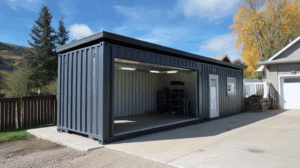From Storage to Shelter: Creating Your Dream DIY Shipping Container Garage
Introduction
If you’re in need of extra storage space or a workshop, consider taking your DIY skills to the next level by transforming a shipping container into your dream garage. Shipping containers are not only versatile and durable but also readily available and cost-effective. In this blog post, we will guide you through the steps of creating your own DIY shipping container garage, from design considerations to the construction process. Get ready to turn a simple storage solution into a functional and stylish shelter for your vehicles and hobbies!
Design and Planning
Assessing Your Needs
Before diving into the project, it’s important to determine your specific needs and goals for your DIY shipping container garage. Consider the number and size of vehicles you want to store, any additional space required for a workshop, and any specific features you desire. This initial assessment will help you make informed decisions throughout the design and construction process.
Sketching Your Design
Once you have a clear idea of your requirements, start sketching your garage design. Take into account the size and layout of the shipping container, as well as any modifications you plan to make. Consider the placement of windows, doors, and ventilation systems to ensure functionality and comfort. Sketching out your design will help you visualize the end result and make any necessary adjustments before moving forward.
Consulting with Professionals
While this is a DIY project, it’s always a good idea to consult with professionals, such as architects or structural engineers, to ensure that your design meets all necessary building codes and regulations. They can provide valuable insights and advice to help you create a safe and structurally sound garage.
Construction Process
Preparing the Site
Before the shipping container arrives, you need to prepare the site where your garage will be located. Clear the area of any debris and level the ground to provide a stable foundation. Consider laying a concrete slab or using concrete footings to ensure the container is properly supported.
Choosing and Preparing the Container
When selecting a shipping container, look for one in good condition with minimal rust and damage. Inspect the container thoroughly for any signs of leaks or structural issues. Once you have your container, thoroughly clean and sanitize it to remove any traces of its previous use. This step is crucial for creating a safe and healthy environment for your vehicles and belongings.
Cutting Openings and Adding Windows/Doors
To transform the container into a functional garage, you’ll need to cut openings for windows, doors, and any other desired access points. Use appropriate cutting tools and techniques to ensure clean and precise cuts. Consider reinforcing the openings with steel framing for added strength and security.
Insulation and Ventilation
To create a comfortable environment inside the garage, insulation is essential. Use high-quality insulation materials to protect against extreme temperatures and reduce noise. Proper ventilation is also crucial for airflow and preventing condensation. Install vents and fans strategically to ensure adequate air circulation.
Electrical and Plumbing
If you plan to use your DIY shipping container garage as a workshop, consider adding electrical outlets and lighting fixtures. Consult with an electrician to ensure proper installation and compliance with electrical codes. If plumbing is required, hire a professional to handle the installation to avoid any potential issues or leaks.
Customization and Finishing Touches
Now it’s time to add your personal touch to the garage. Paint the container in your preferred color scheme to enhance its appearance. Install shelving, workbenches, and storage solutions to maximize functionality and organization. Consider adding a security system to protect your vehicles and belongings.
Conclusion
With some careful planning, creative design, and a bit of DIY know-how, you can transform a simple shipping container into your dream garage. Remember to assess your needs, consult with professionals, and carefully execute each step of the construction process. Not only will you gain valuable storage space, but you’ll also have a unique and stylish shelter for your vehicles and hobbies. So, roll up your sleeves and start building your DIY shipping container garage today!
Thinking Outside the Box: Designing a Unique and Affordable Shipping Container Garage
When it comes to creating a garage space, most homeowners envision a traditional structure made of wood or concrete. However, thinking outside the box and considering alternative options can lead to a unique and affordable solution. One such option is designing a shipping container garage.
Shipping containers have gained popularity not only for their functionality but also for their versatility in design. These sturdy steel structures are used to transport goods across the world, but their potential doesn’t end there. With a little creativity and ingenuity, shipping containers can be repurposed into a stylish and practical garage space.
Benefits of a Shipping Container Garage
Before diving into the design process, let’s explore some of the benefits of opting for a shipping container garage:
1. Cost-Effective
Shipping containers are relatively inexpensive compared to traditional construction materials. By repurposing a shipping container, you can save significantly on the overall cost of building a garage. Additionally, their modular nature allows for easy expansion or relocation if needed.
2. Durability and Security
One of the most significant advantages of using shipping containers is their durability. Made from weather-resistant steel, these containers are built to withstand harsh conditions, ensuring your garage is protected from the elements. Furthermore, their sturdy construction provides enhanced security, keeping your valuable vehicles and belongings safe.
3. Quick and Easy Installation
Unlike traditional construction methods, which can be time-consuming and require extensive groundwork, setting up a shipping container garage is relatively quick and straightforward. Once the container is delivered to your property, it can be modified and customized to meet your specific needs.
Designing Your Shipping Container Garage
Now that we’ve explored the benefits, let’s delve into the exciting part: designing your unique shipping container garage. Here are some design considerations to keep in mind:
1. Size and Configuration
Shipping containers come in various sizes, typically ranging from 20 to 40 feet in length. Consider the space available on your property and the number of vehicles you need to accommodate. Determine whether a single container will suffice or if multiple containers need to be interconnected to create a larger space.
2. Insulation and Climate Control
To ensure a comfortable environment within your garage, insulation is essential. Proper insulation will help regulate temperature, prevent condensation, and reduce noise. Consider adding insulation materials such as spray foam or rigid foam panels to the interior walls and ceiling. Additionally, installing climate control systems like heating and cooling units will further enhance the comfort of the space.
3. Lighting and Ventilation
To create a functional and inviting garage, adequate lighting and ventilation are crucial. Consider installing windows or skylights to allow natural light to enter the space. Additionally, strategically placed LED lighting fixtures will ensure ample visibility during nighttime activities. Proper ventilation, achieved through vents or fans, will help control moisture and odors, ensuring a fresh and ventilated environment.
4. Customization and Aesthetics
One of the most exciting aspects of designing a shipping container garage is the ability to customize its appearance. With a wide range of exterior coatings and finishes available, you can create a garage that seamlessly integrates with your home’s existing aesthetic. Consider options such as cladding, paint, or even adding a living roof to enhance the visual appeal.
5. Functional Features
Think about the specific needs and requirements of your garage space. Consider incorporating additional functional features such as storage cabinets, workbenches, or a car lift if space permits. By optimizing the layout and storage options, you can create a garage that not only accommodates your vehicles but also serves as a versatile workspace.
Bringing Your Unique Garage to Life
Designing a unique and affordable shipping container garage requires careful planning and consideration. By thinking outside the box and exploring alternative options, you can create a functional and visually appealing space that reflects your personal style. Whether you’re a car enthusiast looking for a dedicated workshop or simply in need of extra storage space, a shipping container garage might be the perfect solution. Embrace the possibilities and embark on a creative journey to transform a humble shipping container into your dream garage.
Unlocking the Potential: Step-by-Step Guide to Constructing a DIY Shipping Container Garage
Are you tired of the clutter in your garage? Do you need extra storage space or a workshop? If so, then constructing a DIY shipping container garage may be the perfect solution for you. Not only are shipping containers affordable and readily available, but they also offer a unique and modern aesthetic. In this step-by-step guide, we will walk you through the process of unlocking the potential of a shipping container and transforming it into a functional garage.
Step 1: Planning and Permits
Before you embark on any construction project, it’s essential to have a detailed plan in place. Start by measuring the available space and determining the size of the shipping container you will need. Consider the purpose of your garage and any specific requirements you may have, such as electrical outlets or insulation.
Next, check with your local authorities regarding permits and regulations for constructing a shipping container garage. Each jurisdiction may have different rules, so it’s crucial to ensure that you comply with all codes and requirements to avoid any legal issues down the road.
Step 2: Sourcing a Shipping Container
Once you have your plan and permits in place, it’s time to source a shipping container. There are various options available, including new, used, or refurbished containers. Consider factors such as size, condition, and cost when making your selection. It’s advisable to inspect the container in person before purchasing to ensure it meets your needs and is in good condition.
Step 3: Site Preparation
Before the shipping container can be placed on-site, you will need to prepare the area. Start by clearing any debris or obstructions and ensuring the ground is level. If necessary, lay a foundation or concrete pad to provide a solid base for the container.
Step 4: Delivery and Placement
Once the site is prepared, arrange for the delivery of the shipping container. Depending on the size and weight, you may need to hire a professional moving company or rent specialized equipment for transportation. Make sure to communicate the exact placement location to the delivery team to ensure a smooth process.
Step 5: Insulation and Ventilation
To create a comfortable and energy-efficient space, insulate the interior walls and ceiling of the shipping container. Use materials such as spray foam insulation or rigid foam boards to provide a barrier against temperature fluctuations. Additionally, install ventilation systems, such as windows or vents, to allow for proper airflow and prevent condensation.
Step 6: Electrical and Plumbing
If you plan to use your shipping container garage as a workshop or for storage, you may need to install electrical outlets and lighting fixtures. Consult with a licensed electrician to ensure that all wiring is done safely and up to code. If plumbing is required, such as for a sink or toilet, enlist the help of a professional plumber to handle the installation.
Step 7: Customization and Finishing Touches
Now that the practical aspects are taken care of, it’s time to unleash your creativity and personalize your shipping container garage. Paint the walls in your preferred color, add shelving or storage units, and consider installing a workbench or tool storage system. Don’t forget to incorporate proper lighting to create a bright and inviting space.
Step 8: Security and Safety Measures
To safeguard your belongings and ensure the security of your shipping container garage, consider installing security features. This could include reinforced doors, security cameras, or an alarm system. Additionally, make sure your garage is equipped with fire extinguishers and smoke detectors for added safety.
Step 9: Maintenance and Upkeep
Once your DIY shipping container garage is complete, it’s important to establish a regular maintenance routine. Keep the interior clean and organized, inspect the structure regularly for any signs of wear or damage, and address any issues promptly. Regular maintenance will prolong the lifespan of your garage and keep it in top condition for years to come.
Conclusion
Constructing a DIY shipping container garage is an excellent way to unlock the potential of these versatile structures. With careful planning, proper permits, and attention to detail, you can transform a shipping container into a functional and stylish garage. Follow these step-by-step instructions, and you’ll be on your way to enjoying the benefits of your very own shipping container garage. So, roll up your sleeves, grab your tools, and get ready to create a space that is both practical and aesthetically pleasing.
Transforming Shipping Containers: How to Build a Stylish and Functional Garage

Are you in need of a new garage but tired of the traditional options available? Look no further than shipping containers! These versatile and durable structures have become increasingly popular for their unique and modern aesthetic. With a little creativity and planning, you can transform a shipping container into a stylish and functional garage that will not only provide ample storage space but also enhance the overall look of your property. In this blog post, we will guide you through the steps of building your very own shipping container garage.
Step 1: Finding the Perfect Container
The first step in creating your shipping container garage is to find the right container. You’ll want to take into consideration the size, condition, and features of the container. It’s essential to choose a container that is in good condition structurally, with minimal rust or damage. Additionally, consider the size of the container, ensuring it is large enough to accommodate your vehicles and any other storage needs you may have.
Step 2: Preparing the Site
Before you can start transforming your shipping container into a garage, you need to prepare the site properly. Clear the area of any debris, level the ground, and ensure that the location is suitable for the size of the container. You may need to lay a concrete foundation or construct a raised platform to provide a stable base for the container.
Step 3: Insulating the Container
To make your garage comfortable year-round, it is crucial to insulate the container. Shipping containers are made of steel, which can trap heat in the summer and make the space unbearably cold in the winter. By adding insulation, you can regulate the temperature and create a more comfortable environment. There are various insulation options available, such as spray foam, rigid foam board, or fiberglass batts. Choose the one that best fits your needs and budget.
Step 4: Installing Doors and Windows
To make your shipping container garage functional, you’ll need to install doors and windows. Consider using sectional garage doors for easy access to your vehicles. These doors are not only practical but also add a modern touch to the overall design. Additionally, installing windows will allow natural light to enter the space, making it more inviting and reducing the need for artificial lighting during the day.
Step 5: Electrical and Plumbing
To fully utilize your shipping container garage, you may want to consider adding electrical and plumbing connections. Electrical wiring will enable you to power lights, outlets, and any other electrical equipment you may need. Plumbing connections can be useful if you plan to include a sink or bathroom facilities. Hiring a professional electrician and plumber is recommended to ensure safety and compliance with building codes.
Step 6: Interior Design and Storage Solutions
Now that you have the basic structure in place, it’s time to think about the interior design and storage solutions. Consider installing shelving units, cabinets, or workbenches to maximize storage and create a functional workspace. You can also add hooks or racks to hang tools and equipment, keeping everything organized and easily accessible. Additionally, don’t forget to add proper lighting to ensure visibility and create a welcoming atmosphere.
Step 7: Exterior Finishes
To achieve a stylish and polished look, consider adding exterior finishes to your shipping container garage. Painting the exterior in a color that complements your home’s aesthetic can create a cohesive and visually appealing appearance. You can also add cladding or siding to further customize the design and make it blend seamlessly with the surrounding environment.
Step 8: Landscaping and Security
To complete the transformation of your shipping container garage, pay attention to the surrounding landscape and security. Consider adding landscaping elements such as plants, gravel, or paving stones to enhance the overall look of your property. Additionally, install security measures such as motion sensor lights or a security system to protect your vehicles and belongings.
Conclusion
Transforming a shipping container into a stylish and functional garage is an innovative way to add a modern touch to your property. By following these steps and incorporating your unique design ideas, you can create a garage that not only serves its purpose but also becomes a standout feature of your home. So, why settle for a traditional garage when you can have a shipping container garage that combines functionality, style, and sustainability? Start planning your transformation today and enjoy the benefits of this creative and unique solution.
The Ultimate Guide to Building Your Own DIY Shipping Container Garage
Are you in need of extra space for your vehicles, tools, or workshop? Building a DIY shipping container garage might be the perfect solution for you. Shipping containers are not only durable and cost-effective but also versatile and easy to work with. In this ultimate guide, we will walk you through the step-by-step process of creating your very own shipping container garage.
Step 1: Planning and Design
Before diving into the construction process, it’s crucial to plan and design your shipping container garage. Consider the size and layout you want, taking into account the number of vehicles or equipment you need to store. Determine the number of shipping containers you’ll need and decide on their arrangement.
It’s also essential to check local building codes and regulations in your area. Consult with a professional architect or contractor to ensure compliance with all necessary permits and requirements.
Step 2: Sourcing and Preparing the Containers
The next step is to find suitable shipping containers for your garage. Look for containers that are in good condition and free from major structural damage. You can often find used containers at a reasonable price from shipping container dealers or online marketplaces.
Before starting any modifications, thoroughly clean the containers and remove any rust or debris. Inspect the floors, walls, and ceilings for any signs of damage and repair as needed. Apply a layer of rust-resistant paint to protect the containers from future corrosion.
Step 3: Foundation and Site Preparation
A solid foundation is crucial for the stability and longevity of your shipping container garage. Depending on the soil conditions and local regulations, you can choose from various foundation options, such as concrete slabs or footings.
Prepare the site by clearing any vegetation, leveling the ground, and ensuring proper drainage. Mark the locations for the foundation and anchor points to secure the containers in place.
Step 4: Container Modification
One of the advantages of using shipping containers for a garage is their versatility. You can modify the containers according to your specific needs and preferences. Here are some popular modifications:
- Cutting Openings: To create vehicle access, you’ll need to cut openings for doors and windows. Use a plasma cutter or a reciprocating saw to carefully cut through the steel walls, reinforcing the edges with steel framing.
- Insulation: Shipping containers are not naturally insulated, so adding insulation is crucial for temperature control. Use spray foam insulation or install rigid foam panels on the interior walls and ceilings.
- Electrical and Plumbing: If you plan to use your garage as a workshop or storage space, consider adding electrical outlets, lighting fixtures, and plumbing connections. Consult with a licensed electrician and plumber to ensure proper installation.
- Ventilation: Proper ventilation is essential to prevent condensation and maintain airflow within the garage. Install vents or fans to keep the space well-ventilated.
Step 5: Container Assembly and Joining
Once you have prepared the containers and made the necessary modifications, it’s time to assemble and join them together. Welding is the most common method used to connect the containers securely. However, if you’re not experienced with welding, you can use bolts or brackets to join them.
Make sure to align the containers accurately and level them to maintain structural integrity. Reinforce the connections with steel beams or columns for added stability.
Step 6: Finishing Touches
To make your shipping container garage functional and visually appealing, consider adding some finishing touches:
- Flooring: Install a durable and easy-to-clean flooring material, such as epoxy coating or rubber mats.
- Interior Walls: Paint the interior walls with moisture-resistant and easy-to-clean paint. Consider adding pegboards or shelving for organizational purposes.
- Exterior Finishes: Apply a weather-resistant paint or cladding to protect the exterior of the containers from harsh elements.
- Security Measures: Install sturdy doors with secure locks and consider adding surveillance cameras or an alarm system for added security.
Step 7: Moving In and Organizing
Once the construction is complete, it’s time to move your vehicles, tools, and equipment into the newly built shipping container garage. Organize the space efficiently, making use of shelves, cabinets, and designated areas for each item.
Conclusion
Building your own DIY shipping container garage can be a rewarding and cost-effective project. With careful planning, preparation, and execution, you can create a functional and stylish space to meet your storage needs. Remember to follow all safety guidelines and consult professionals when needed. Happy building!




